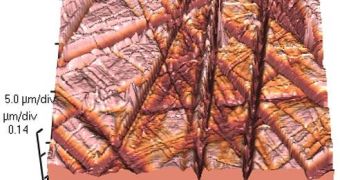Using an atomic force microscope to detect all the subtle changes that occur within a material when it's pulled apart or compressed is a very good method of scientific observation. Unfortunately, it's also one of the most expensive, so researchers at the University of Illinois have only recently devised a new way of doing the same thing, one that is just as efficient and also much cheaper.
They use the stilbene compound, which is a small and inert structure, to pull a material apart or to compress it, atom by atom. This level of control is unprecedented and could give experts a better idea of how the molecular structure of various types of materials modifies depending on the certain amounts of pressure that are applied on it.
“By pulling on different pairs of atoms, we can explore what happens when we stretch a molecule in different ways. That information tells us a lot about the properties of fleeting structures called transition states that govern how, and how fast, chemical transformations occur,” UI chemistry professor Roman Boulatov, the author of a new study detailing the find, explains.
The paper, on which research associate Qing-Zheng Yang, postdoctoral researcher Daria Khvostichenko, and graduate students Zhen Huang and Timothy Kucharski have also collaborated, has been published on March 29th in the online edition of the journal Nature Nanotechnology.
“Localized reactions offer the best opportunity to gain fundamental insights into the interplay of reaction rates and molecular restoring forces, but these reactions are extremely difficult to study with a microscopic force probe. By replacing microscopic force probes with small molecules like stiff stilbene, we can study the relationship between restoring force and reaction rate for localized reactions. The more accurately we know where our probe acts, the better control we have over the distortion, and the easier it is to interpret the results,” Boulatov adds.
“Unlike a rubber band, which will always break faster when stretched, pulling on some chemical bonds doesn't make them break any faster; and sometimes it's a bond that you don't pull on that will break instead of the one you do pull. That's because experiences in the macroscopic world do not map particularly well to the molecular world. Even small molecules will stretch and deform in many different ways, making the study of molecular forces even more intriguing,” he concludes.

 14 DAY TRIAL //
14 DAY TRIAL //